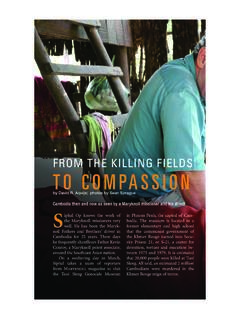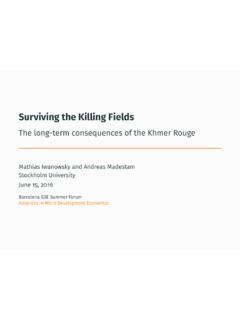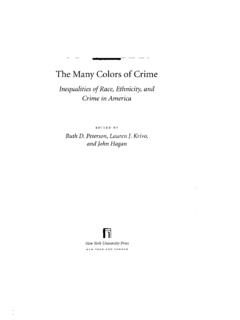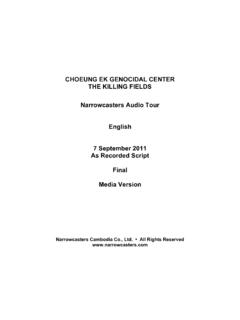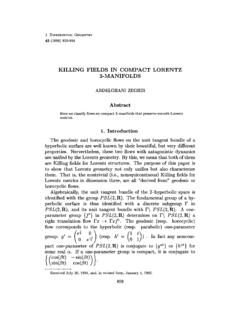Transcription of The Killing Fields of Alethankyaw - kaladanpress.org
1 The Killing Fields of Alethankyaw blank The Killing Fields of Alethankyaw Kaladan Press Network First Rohingya News Agency (since 2001). DEDICATED TO. THE ROHINGYA PEOPLE OF ARAKAN. First Edition November 2018. Copyright Kaladan Press Network Published by Kaladan Press Network Box #773. Chittagong 4000, Bangladesh Website Contents A centuries-old Rohingya community Unfinished business from World War Two Southern Maungdaw's fishing hub A tightening security noose Rohingya fishing livelihoods progressively crushed The August 2017 clearance Signs of pre-planning Security heightened.
2 Boats seized Troop reinforcements move in Rakhine villagers evacuated Step-by-step expulsion Pre-dawn shock assault The exodus begins Hundreds more troops trucked in Attempts to stay on Deadly snipers on telecommunication towers Killing Fields Disposal of bodies Ransacking and looting Clearing out the periphery All to ashes No sign of mass terrorist attack Questioning the government narrative Telenor and complicity Summary of Security build-up around Alethankyaw 2012-2017 Bangladesh Maungdaw Burma Ra kh Bay of ine Bangla Bengal Naf desh River Mayu mountains Alethankyaw Burma Army bases/camps camps/outposts BGP camps/outposts resettlement villages resettlement villages Buddhist resettlement villages Original villages Road 0 5.
3 New restricted security road International border kilometers 8 The Killing Fields of Alethankyaw Summary The centuries-old fishing community of Alethankyaw in southern Maungdaw is one of hundreds of Rohingya villages attacked and razed by Burmese government security forces during their brutal clearance operations that began in August 2017 and which drove over 720,000 refugees into Bangladesh. The government maintains that the operations were in response to coordinated terrorist attacks on August 25. on thirty police posts, including in Alethankyaw , and that villagers burned their own houses and fled.
4 But this report, based on in-depth interviews with thirty refugees from Alethankyaw , including fishermen, farmers, shopkeepers, housewives and teachers, tells a very different story: the nine-day assault by the Burma Army on their village was carefully pre-planned and implemented, and the 1,000-strong terrorist attack on Alethankyaw as described by the government did not and could not have happened. Security infrastructure for the August 2017 operations was set in place well in advance. After the state-incited communal violence of 2012, the Burma Army had significantly expanded into southern Maungdaw to fortify the Naf estuary frontier the so-called western gateway for extremist attacks.
5 New military bases were built along the foot of the Mayu mountains. These were linked by a new restricted road to existing Border Guard Police (BGP) camps and Buddhist resettlement villages, which together strategically cordoned off the coastal plain from the mountainous hinterland. The Killing Fields of Alethankyaw 9. A new military camp was also built on the beach next to Alethankyaw . The security net tightened further after the initial clearance operations of October 2016, with military and police forces ramping up raids on Rohingya villages, and enforcing new restrictions, including grounding all Rohingya fishing boats, which paralyzed the fishing trade and cut off the main income source for the community.
6 By early August, there was thus a large locally based military force already in place to launch the 2017 clearance operations together with the combat divisions flown in from central Burma that month. Villagers in Alethankyaw saw clear warning signs of the impending assault. Hundreds of troops were deployed into the village days beforehand, reinforcing the regional BGP camp in the centre of the village, as well as the two BGP outposts and army camp close to the beach. Two navy ships were moored off the shore. The army evacuated Rakhine inhabitants of the village by truck during the evening of August 24.
7 Late that night, the Rakhine village administration officer phoned to Rohingya section leaders telling them that the army was going to shoot, and they should be ready to run. Despite the overwhelming presence of security personnel, who were on heightened alert, the government claims that early on August 25, a thousand extremist terrorists swarmed up from the wide, flat beach and attacked an Alethankyaw police post. No interviewees saw any evidence of this large- 10 The Killing Fields of Alethankyaw scale insurrection. They say it was logistically impossible for Rohingya to have organized such an attack, and it was the security forces who opened fire on the village without any external provocation.
8 At least fifty men, women and children were killed early that morning, mainly in the central sections of the village. At dawn, terrified villagers began evacuating en masse towards the Naf River to cross over to Bangladesh. Over the next nine days, hundreds more troops were trucked in from the Kanhpu army base nearby. They patrolled around the central sections of the village, looting the market, seizing women, and shooting at civilians. Burma Army snipers positioned on the tops of the MPT and Telenor telecommunication towers were able to target a wide range around the village.
9 Well over a hundred villagers were killed as they fled or tried to hide near their homes. Scores of bodies were dragged by troops and thrown into wells, as well as dumped under the Telenor tower, and into a pond near the beach. By August 29, the centre of the village had been emptied, and the army began targeting the outer village areas. Troops marched on the Byuhakon section along the beach, where they tortured, killed and raped civilians, causing the remaining inhabitants to flee. That day, they began torching houses, and by early September, most of the village was in ashes, deserted by its over 11,000 Rohingya inhabitants.
10 The army's methodical clearance of Alethankyaw 's entire The Killing Fields of Alethankyaw 11. population, first from the central sections of the village, and then from outlying sections, until all Rohingya inhabitants were either dead or had fled in terror, demonstrate that this was precisely the goal of the operation: to terrorise and expel the Rohingya, making sure they did not dare return. It is evident that the clearance operations in Alethankyaw were carefully pre-planned and executed, and that they were not triggered by a terrorist attack.
